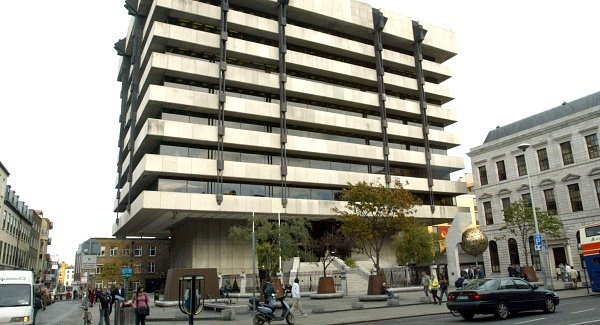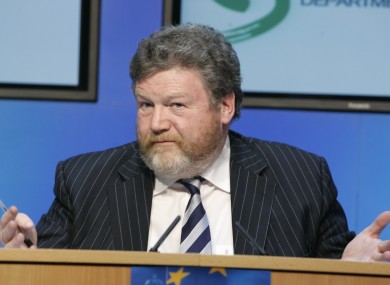Ireland need’s better mortgage solutions
ONE THAT FAVOUR’S IT’S BORROWERS
It’s a few years late, but the Central Bank’s new plan to help homeowners is worth a try
The Central Bank has launched a pilot scheme to help homeowners. It is called the Framework for Multiple Distressed Debt.
It’s a pity we didn’t have it four years ago. The plan requires lenders to work together to achieve sustainable and fair outcomes for homeowners in financial difficulty.
I will set out what is involved and why we should give it a chance. It is not for impaired business loans and there is nothing for those in trouble with buy-to-let properties.
The banks still call the shots, but the framework encourages participating lenders to find sustainable solutions for keeping borrowers in their homes. This is to be achieved by what it calls a “Restructuring Waterfall”. If this pilot scheme works and produces workable criteria that borrowers can rely on, it could help those who are struggling to hold on, as well as those who are already in arrears.
It is worth looking at the background to what has happened before we look at the proposed framework.
In 2009 the Central Bank produced a Code of Conduct on Mortgage Arrears (CCMA) which sets out the Mortgage Arrears Resolution Process that imposes five steps on lenders. They must (1) communicate with the borrowers.; (2) use a standard financial statement to gather financial information; (3) assess the borrower’s case; (4) consider options that might resolve the problems; and (5) consider appeals.
You can’t fault the process, but it hasn’t produced the solutions.
At the end of 2012, there were 792,096 private mortgage accounts for principle dwellings in Ireland, and 143,851 were in arrears. Most were over 90 days and many for over two years.
CCMA has been in place for a number of years, but there were 106,000 cases that had not been restructured at the end of 2012.
Last year a panel of accountants was set up, to help borrowers understand options that the banks might offer. It would be a step in the right direction, but not a solution in itself. By the end of June 2013, borrowers can use the new personal insolvency legislation to claw their way back, if they are insolvent. This involves engaging with a Personal Insolvency Practitioner, or PIP, to broker a deal with the financial institutions. It divides those in trouble into three categories.
The first two deal with unsecured loan and demand credit (credit cards and overdrafts). The third includes secured debts such as mortgages. The plan requires the Personal Insolvency Practitioner to broker a deal between financial institutions and borrowers. Only co-operative borrowers who engage with their lenders to find solutions will be covered.
The process remains one-sided, in favour of the financial institutions. Not everyone is insolvent, but many need to restructure their finances to get back on track. The new framework could help everyone, as it points the way for lenders to proceed. The pilot scheme will be operated by a third-party service provider.
Hopefully it will not be like the Credit Review Office where ex-bankers review what bankers do. We need solutions that favour borrowers. Up to now they can ask for a solution, but they have no right to expect one, or what it might be. There was no blueprint to carve out a deal.
We know what is possible, such as longer payback terms, interest-only arrangements and more. But any deals that have been done took place behind closed doors and those involved were sworn to secrecy. All we know is that the borrower will be made suffer, if they are to get any deal.
NOT MUCH HAS CHANGED.
The pilot scheme will last for three months from the time it begins. The plan is to get over the hurdles facing multiple financial institutions that are dealing with one borrower. Under the new personal insolvency arrangements, a deal requires the agreement of 65 per cent of the creditors. In most cases the lender providing the mortgage will be in control. Unsecured lenders could be left out in the cold.
The Central Bank’s proposals will get the financial institutions working together so that they can agree a framework that they can all live with. If they cannot work together the personal insolvency legislation is dead in the water. The Central Bank’s Restructuring Waterfall, if adopted by financial institutions, might help impaired borrowers take the first step on the road to recovery.
While there are nine outcomes under this framework, they can be broken down into three main scenarios.
Firstly, are the borrower’s debts affordable or not? Maybe the borrower just needs to tighten their belt and get on with it. Secondly, there are six proposals to deal with various levels of indebtedness. And thirdly, for those in crisis, the mortgage would require radical restructuring, possibly a write down.
Most of the solutions that the banks must consider work outside the personal insolvency process. Scenario 2, in particular, proposes such a framework. If the Restructuring Waterfall works, you could avoid life on the breadline.
There are six possibilities under Scenario 2. They all envisage debts, secured and unsecured, being repaid in full. If things can be sorted out in six months, a little flexibility is all that’s needed.
In the case of demand credit (credit cards and overdrafts), the borrower could be given five years to repay and interest of 9 per cent would be charged.
If a mortgage is not being serviced as required, the term can be increased by whatever it takes, subject to the borrower being no more than 65 at maturity. Any unsecured loans and demand credit would be dealt with as outlined above. If the financial problems are more acute, the interest rate applied to unsecured debts and demand credit could be cut to 4.5 per cent.
Finally, in addition to the above, the mortgage interest rate could be cut to no more than 4.5 per cent for a period of five years. If a tracker rate applied that would be preserved.
When the pilot scheme has run its course, we should have a better idea as to whether the banks will be reasonable. Don’t hold your breath.
James Fitzsimons is an independent financial adviser specialising in tax and financial planning
Eamon Gilmore rejects his Cabinet colleagues claim on cutting child benefit
Child benefit cut claim to pay for an extra free pre-school year is ruled out by the Tánaiste Eamon Gilmore who has firmly ruled out suggestions by Cabinet colleagues that some of the money currently spent on child benefit could be used to fund an extra free pre-school year.
Asked by journalists about the issue, Eamon Gilmore said the issue of cutting child benefit was never on the Government’s agenda.
He added that Minister for Education Ruairí Quinn had never said child benefit would be cut to pay for an extra free pre-school year.
“The proposal made by Ruairí Quinn was a proposal that we’d need to have a discussion about having a second year of free pre-school education. And I think it’s timely that we have that discussion,” said Mr. Gilmore.
Childcare costs
“As we all know, the cost of childcare is very high for families and we also know that there are educational benefits to pre-school education and what Ruairí Quinn was talking about was having a discussion,” he said.
“The question of cutting child benefit was never on the agenda,” added Mr Gilmore.
Last week Mr Quinn was widely quoted as saying that he gave his “full support” to the idea of using part of the €2 billion child benefit budget to fund a second year of State-sponsored pre-school.
Education conference
Speaking at an Economic and Social Research Institute conference on education, Mr Quinn said Government colleagues Minister for Social Protection Joan Burton and Minister for Children Frances Fitzgerald had “rightly argued” in favour of the move to a “more effective” use of the child benefit budget.
Speaking at an Economic and Social Research Institute conference on education, Mr Quinn said Government colleagues Minister for Social Protection Joan Burton and Minister for Children Frances Fitzgerald had “rightly argued” in favour of the move to a “more effective” use of the child benefit budget.
“They have both together cogently argued that we need to explore expanding this provision to two years of free pre-school education for all our children,” he said.
Research revealed at the conference indicated that high quality pre-school education shows “lasting benefits” for better academic attainment and socio-behavioural outcomes.
The Government spent €175 million last year on the free pre-school programme, which is currently supporting in the region of 68,000 pupils.
Mr Quinn suggested the cost of doubling this provision would be in the region of €150-€175 million.
“I fully support seeking to do this within the lifetime of this Government,” he added.
“Child benefit is about what is the best benefit you can give a child. That – particularly in relation to a child coming from a disadvantaged background – means levelling the playing field in the world of education,” he said.
Second year
“If we could get two years as distinct from one it would really have the potential to transform the learning outcomes and the educational outcomes of a whole cohort of young people.”
“If we could get two years as distinct from one it would really have the potential to transform the learning outcomes and the educational outcomes of a whole cohort of young people.”
In the meantime, he said, Ireland could move “with limited further funding and in a short time” to enhance an effective quality assurance and inspection system focusing on educational outcomes across the pre-school sector.
Minister for Children Frances Fitzgerald also appeared to back a move to divert some of the €2 billion child-benefit budget towards funding a second year of free pre-school.
However, internal Government estimates suggest the move would be expensive and would likely cost between €175 million and €200 million per year.
Plans to introduce a much more ambitious Scandinavian-style childcare service for under-12s would cost about €2 billion, according to estimates provided to the Government.
Proposals to either tax or means-test child benefit which have been mooted at regular intervals over the past two decades, would deliver enough money to pay for the move.
Lawyers for Savita Halappanavar husband to meet the head of HSE probe


Lawyers for Savita Halappanavar’s husband will meet the head of a health service investigation this week, paving the way for publication of a long-awaited internal report on her death.
Praveen Halappanavar had postponed the meeting with Professor Sabaratnam Arulkmaran until after the inquest into Savita’s death, which concluded last month that she died of medical misadventure.
His lawyer, Gerard O’Donnell and his friend, CVR Prasad, a hospital consultant, will meet Prof Arulkumaran in Galway city on Wednesday.
Mr Halappanavar decided not to attend the meeting himself.
They are expected to make detailed submissions, based on evidence that emerged over the course of the eight-day inquest in Galway last month.
After it concluded, Mr Halappanavar launched a passionate attack on her “horrendous, barbaric and inhuman” treatment at the hospital, claiming she was just left there to die.
Savita, 31, died at Galway University Hospital on October 28 last year after she miscarried her baby at 17 weeks. The inquest was told of a litany of systems failures and communications failures and how the medical team missed the early signs of blood poisoning that eventually killed her.
The inquest heard how her requests for a termination were refused because her life was not at risk.
Prof Arulkumaran, a London-based obstetrician, was commissioned by the HSE to chair a clinical review of Savita’s death.
Mr Halappanavar had initially refused to co-operate, instead calling for an independent public inquiry. He was further upset when a draft of Prof Arulkumaran’s findings was leaked to the media.
The draft report found there was an over-emphasis on the welfare of the foetus and an under-emphasis on Savita’s deteriorating health.
One of the issues at the meeting will focus on whether any issues have emerged between evidence given at the inquest into Savita’s death and the HSE investigation.
“One of the first things is whether the chairman has reviewed the transcripts of evidence from the inquest and whether the chairman has any amendments to draft as a result,” he said.
Mr O’Donnell will be accompanied to the meeting by Mr Prasad, an orthopaedic surgeon in Galway who testified at Savita’s inquest.
After the inquest, he said it was “mind-boggling to all of us how a person goes in to a hospital, walking, and comes out in a box for something that was an entirely preventable death”.
Health Minister Reilly say’s sorry to singing Nurse for saying ‘stick to the day job’
MINISTER ANNOUNCES CREATION OF NEW POST OF CHIEF NURSING OFFICER AT DEPARTMENT OF HEALTH
An emotional nurse Bolatito Aderemi speaking to the media after her private meeting with Minister for Health James Reilly at the INMO conference in Letterkenny today.
As he left the conference hall following his address, some delegates chanted: “no more cuts.”
One delegate, Bolatito Aderemi from the Dublin South West branch, started to sing: “All we are saying is enough is enough.”
As he passed her Dr Reilly said she should “stick to her day job”.
A number of delegates objected to the Minister’s comments and said the union should seek an apology.
Dr Reilly later met with Ms Aderami privately and apologised.
He said he had made a quip as he left the hall. He said he had been informed that someone had taken offence. He said he had not intended to offend anyone.
Ms Aderemi, who is originally from Nigeria, said the Minister had shaken her hand, tried to give her a hug and said he was sorry and did not mean to embarrass her. She said she accepted his apology.
Dr Reilly had been greeted in silence as he arrived at the conference. However he received applause following an anouncement that nurses would hold senior leadership positions inthe proposed new hospital groups and in the Department of Health.
He said each of the proposed new hospital groups, to be announced formally next week, will have to have a director of nursing as a full executive on the management team.
“I will (also) establish a new chief nursing officer role within the Department of Health, that this role will be at assistant secretary level and a full member of the management advisory committee and will have executive authority to lead the nursing profession in Ireland and represent its perspective both to Government and internationally.”
Dr Reilly told delegates that pay savings of €150 million had to achieved in the HSE this yearin addition to the many reforms and efficiencies designed to improve servies and to live within its budget.
“Frankly, we are between a rock and a hard place.”
The Minister said that management and unions were meeting at the Labour Relations Comission to explore all the avenues open to try to reach a resolution to reducing the paybill.
“If we can find such anagreement it would be so much better than an imposed solution.
However he said the country was borrowing €1 billion per month and that this could not continue.
Gun fire shots fired through window of a Sligo Cranmore house


Left picture McDonnell Drive in Cranmore, Sligo City
The incident happened at around 4am this morning but neither the two adults nor the two children in the house at the time were injured.
A number of shots were fired through the window of a house in the Cranmore area of Sligo this morning.
The shots were fired through the window of the house on Joe McDonnell Drive, where two adults, a woman aged 27 and a man aged 31, and two children were staying, at around 4am this morning.
No one was injured in the incident and the scene has been sealed pending a technical examination by Gardaí.
The matter is under investigation, a Garda spokesperson said.
Spaceman Chris Hadfield shares one last picture of Belfast before returning to earth


He is due to fall back to Earth tomorrow – but spaceman Chris Hadfield has tweeted another picture of Belfast from space.
Commander Chris Hadfield is a Canadian astronaut and serial tweeter who has been snapping photos of Earth from the space station and sharing them online.
But as he entered his final 24 hours aboard ISS he tweeted a picture ofBelfast, quizzing followers: “Belfast, at the mouth of the River Lagan. Strangely, not the river the city was named after. Who can tell me why?”
Dozens responded on the social media site, debating the reasons why the city was named after the River Farset (Béal Feirste – the Mouth of the Farset) which is now contained within a tunnel under the High Street.
Hadfield, who has a daughter studying at Trinity College in the Republic, has previously shot and tweeted two photos of Dublin.
He also provided the first message tweeted from space in Irish — Tá Éire fíorálainn! (Ireland is exquisite). He added: “Land of green hills dark beer. With Dublin glowing in the Irish night.”
The astronaut has been aboard the space station since December carrying out scientific experiments.
The space station orbits earth every 92 minutes at 8km per second.
Today he said: “Almost time to leave Station. Hard to express all of my emotions, but mostly gratitude. I came here on behalf of so many





No comments:
Post a Comment